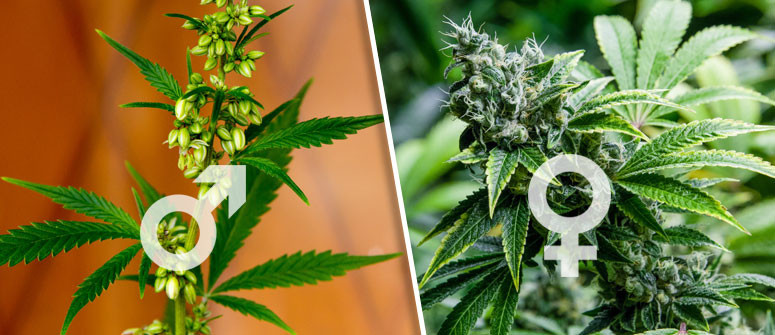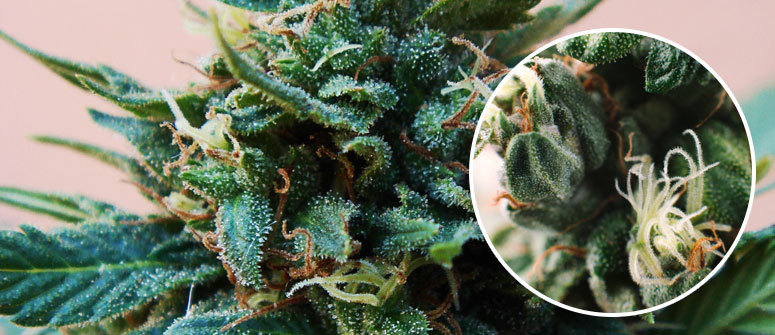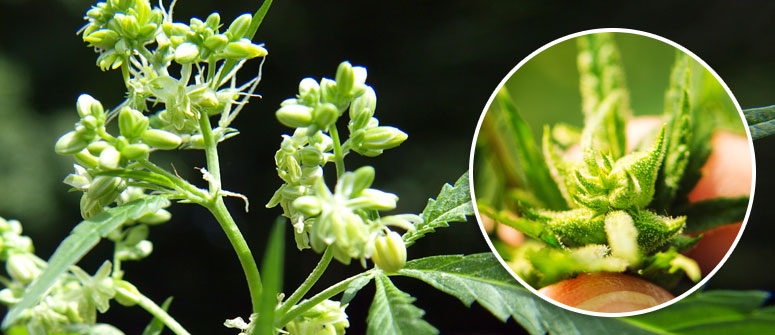What’s the difference between male & female cannabis plants?

All cannabis plants are beautiful in their own way, but you'll find that male and female specimens have very different things to offer. While female plants will yield the resinous buds stoners know and love, males grow pollen sacs instead. What does that mean for the grower? You'll find out more in our discussion on male vs female weed plants.
Contents:
If you aren't too familiar with growing cannabis, you might think that all the plants grow in the same general way. It's true in a certain sense, seeing as they're members of the same species, but things get complicated when biological sex comes into play. So we take a closer look at the differences between male and female cannabis plants.
See, they might look similar in the beginning of the growing process, but you'll notice some differences pop up as they continue to rise towards the sky. It's key you notice these differences between male and female plants early on, too, as things can get troublesome if you let the male and female plants grow near each other.
UNDERSTANDING CANNABIS PLANT SEX: WHY IS BEING DIOECIOUS IMPORTANT?
So, we've covered the fact that there are male and female cannabis plants, but we still have some explaining to do as far as why. After all, not all plants have males and females within their species, so why is that the case for cannabis?
Well, just as the dynamic goes for various other species, male and female plants are biologically designed to reproduce with each other, producing more refined and robust genetics that will ensure the continuation of the species.
To be more specific, when cannabis plants are able to share their genetics via reproduction, their offspring have a better chance of resisting certain pathogens, diseases, and other harmful presences in their environment. In turn, when those plants with resistances are able to reproduce, the resulting seeds are that much more optimised in turn.
If you ask cannabis breeders, you'll find that this reproductive process is good for a lot more than ensuring survival. See, if a breeder notices two strains with certain desirable traits, they can bring a male and a female from each strain together, plant the resulting seeds, and enjoy a whole new strain!
For example, you could select one strain for its large yields, and breed it with another known for its high THC content. You could then breed the resulting strain with a mould-resistant cultivar to boost the resistance of future generations. The result might not be exactly what you'd expect every time, but experimentation is all it takes to eventually find that perfect result.
HOW TO IDENTIFY FEMALE CANNABIS PLANTS

With a clearer sense of why female and male cannabis plants exist, the next step is being able to identify the sex of individual plants. To start, we'll focus on female plants, which are the ones that provide us with those tasty, smokable buds.
It can be hard to tell early on, but female plants first start to show themselves about 3–6 weeks into the vegetative stage, as small hairs begin to appear at the nodes of stems. They're known as stigmas, and they serve as the “arms” of the pistil, which is the main female sex organ in cannabis plants.
Within this explanation, we can also detail how, exactly, cannabis plants reproduce. As the plants mature, males develop pollen sacs that eventually open and spread pollen to nearby female plants via the air.
The extended stigmas on the females will catch the pollen and send the genetic information to the pistils. The energy they were using—or would be using—for resin production will now be used to produce seeds.
As far as the female plant was concerned, its only job was to capture the pollen, and, in turn, it won’t bother producing many more trichomes. That shift in energy now leads to yields of seeds rather than yields of bud.
But, what happens if there are no male plants around, then? Well, once a female plant makes its way into the flowering phase, if no pollen is present, it'll energy into producing bigger flowers at the pistil sites, in the hopes of coming into contact with pollen. By the end, it may not catch any pollen, but it will capture your heart with a hefty yield of resinous bud.
HOW TO IDENTIFY MALE CANNABIS PLANTS

So, if female cannabis plants can be identified by their pollen-catching stigmas, what factor distinguishes a cannabis plant as male? We hinted at it earlier, but the main sign to look for is the development of pollen sacs. Male pre-flowers behave exactly like the female counterpart: they appear in the pre-flowering stage and look like small, green bulbs situated at the nodes.
They look harmless at first, but if you're trying to get the biggest yield possible out of your females, bursting pollen sacs can spell disaster for your harvest. However, they are actually very helpful for breeding cannabis plants. As we mentioned earlier, your female plants will take the pollen as a sign that they shouldn't develop any more trichomes, and instead will spend all that energy on making seeds that'll include genetics from the male plants.
WHEN DO MALE CANNABIS PLANTS PRODUCE POLLEN?
But, when would a male plant know it's time to release its pollen? Is there a certain time when they feel ready to begin the reproductive process?
Not exactly. You see, it's not uncommon for pollen sacs to open as early as the late vegetative stage, so it’s crucial you keep an eye on the pre-flowers as soon as they start forming. The amount of time the sacs need to fully open and start spreading pollen isn't an exact science, but, if you’re not interested in breeding for seeds, it’s better to act early to ensure high-quality sinsemilla.
Overall, if you want to make sure they don't reproduce with the females, you'll want to identify and remove your male plants the second their pollen sacs appear. There's no need to wait until they're mature or ready to burst; just get them out of the ground and away from your female plants as soon as you notice those pesky sacs developing.
WHAT CAN YOU DO WITH MALE CANNABIS PLANTS?
So, you've got the male plants out of the growing space, but what happens now? You spent all this time growing and taking care of them up until this point, so it would be a shame to throw them all away. Thankfully, there are some surprisingly simple ways to use male cannabis plants outside of breeding.
Hungry for some edibles, maybe? The minute amount of trichomes on the surface of male buds can be used to craft some weak but delicious edibles, while the leaves can be incorporated into a lovely salad. The fibres can also be used to form twine or rope, serving as a cheap and effective alternative to conventional materials.
SHOULD YOU GROW MALE OR FEMALE CANNABIS PLANTS?
With all this in mind, there comes a question: should you grow male cannabis plants, female plants, or both? Well, it depends on what you're trying to achieve. If you only need them as companion plants and sources of fibre, and you don't want to deal with buds, some male plants will do you good.
If you're trying to breed new strains and experiment with different genetic combinations, then both male and female plants are necessary. You won't have to ask for this specifically, as a pack of regular cannabis seeds will, on average, contain both biological sexes in near-equal proportion.
However, if your main focus is getting the highest-quality buds possible, and the largest amount you can gather, you'll want to make sure you're only growing female plants. You can still purchase regular seeds in this situation, although you'll have to identify and eliminate any males from your garden as we mentioned earlier.
Alternatively, you could spend a bit more money on feminized seeds. These provide around a 99% guarantee of growing female plants. This way, you can grow great buds without worry!




